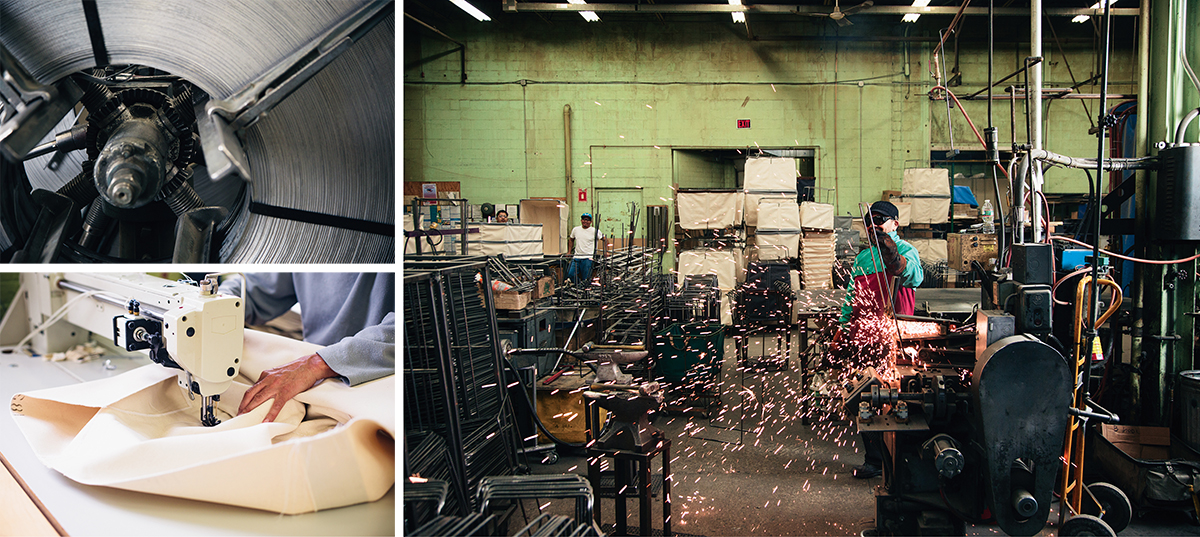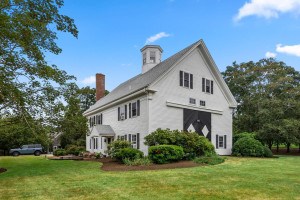Steele the Show

Photograph by Pat Piasecki
Walk down to the fishing docks on any given day and you might see them in a row—huge canvas baskets overflowing with shimmering fish packed on ice, the word “Steele” hand-stenciled in thick, black ink on one end. Retailers like Ralph Lauren use them to store housewares and clothes, while others, such as West Elm, sell them directly to customers. Colleges and universities deploy the big, wheeled industrial baskets to move freshman from their parents’ SUVs to their pintsize dorm rooms. Even the balloons flying high in the Macy’s Thanksgiving Day Parade are stored inside Steele Canvas containers. Increasingly, homeowners are using the collection of rugged storage objects—crafted from start to finish in the small company’s production space in Chelsea—in laundry rooms, mudrooms, or their children’s playrooms. Steele Canvas’s practically indestructible baskets, bags, and laundry caddies are in particularly high demand.
“Everywhere you look, our products are behind the scenes, making things move,” says director of marketing Paul Geffken. Since the family-run company was founded in 1921, it’s had a place in American history. The classic “188” tote bag, for instance, was designed to hold heavy loads of ice and coal, and was commonly used during World War II. Twenty years later, butterfly chairs—made popular by MoMA curator Edgar Kaufmann, Jr. in the 1940s—were manufactured in Steele Canvas’s original Cambridge factory and sold in Benjamin Thompson’s innovative Harvard Square retail store, Design Research. And today, global security company Brink’s transports dollars around the country in heavyweight duck canvas bags, made right here in Chelsea.

Clockwise from top left: this machine holds steel, which is used to reinforce baskets; a flash welder works his magic on a steel caddie frame; Steele Canvas’s products are stitched by hand in a Chelsea factory. / Photographs by Pat Piasecki
Foreman Raul Aliaga manages the 24,000-square-foot production floor, where canvas is hand-cut and stitched, steel reinforcements are manipulated, and castors and handles are attached to create roughly 200 baskets a day. He’s been with the company for 35 years and, like many of Steele Canvas’s employees, contributes to the design of new products. The company has collaborated with J.Crew on a gym bag, and with Urban Outfitters on a tote. Crate & Barrel is stocking Steele Canvas’s commercial-style baskets in various shapes and sizes. “We all get together and we have different materials out and a piece of canvas,” explains Geffken. “It’s blank. We each contribute ideas, and in the end try to put something together we like and we think our customers will appreciate.” Steele Canvas baskets are also available locally at Sault New England, Michelle Willey, and White Magdelena House, in Hingham.
Geffken says materials are sourced locally whenever possible, although it was a lot easier to do so in the heyday of American manufacturing. Steel, which is used as frame reinforcements in most industrial baskets, originates in Canada. Dyed canvas comes from New Jersey, while the standard cream-colored canvas is brought in from South Carolina, says Geffken. Patterns are cut precisely using templates and an electric knife in a way that produces little to no fabric waste (most leftover fabric becomes handles). Then the stencil is hand-applied and the pieces are sent to the stitching department for assembly.
“Times have changed,” Geffken says. “People want something that’s going to last, and our stuff stands the test of time. I tell parents they can put toys in one of our baskets, and with any luck their kids can take it with them to college.” He rolls a worn, gray, waxed-canvas container toward me. Although it’s frayed around the edges and it looks like it’s been on a battlefield, there are no obvious holes or damage. “Some guy got this in the 1960s used, and he used it for yard cleanup for more than 40 years,” he says. He ordered a new one, but Steele Canvas held onto the relic. “It’s been used and abused,” Geffken says proudly, “but it’s living proof that our baskets last forever.”

From left: a Steele Canvas employee stitches a vibrant, vinyl-coated nylon; a worker rivets canvas handles onto an “82” industrial truck. / Photographs by Pat Piasecki

Clockwise from top left: steel rods (like the one being bent here) are shipped in from Canada; the company has been using this machine to straighten and cut coiled steel since the 1970s; nearly 72,000 yards of natural canvas are used each year. / Photographs by Pat Piasecki

From left: Canvas baskets with leather rims waiting to be shipped to Tokyo-based Akira; Steele Canvas’s “152” elevated natural-canvas trucks and “122-S” vinyl-coated nylon trucks are perfect for laundry. / Photographs by Pat Piasecki


